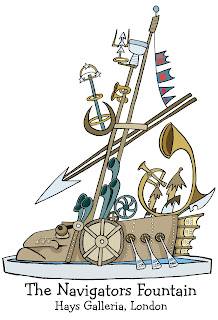A History of a Charity in Twenty Objects - #10
#10. Rubber Glove (February 2008)
In late 2007, we received a call from St Martin’s Property Corporation, offering Guy Fox a donation of the coins from the fountain at Hay’s Galleria.
Hay’s Galleria is a warehouse building on the south side of the Pool of London. It was built around a wet dock, where ships filled with tea and other exotic foods were offloaded. The stevedores are long gone. The dock is now filled in, and the warehouse has been converted into shops, restaurants and offices; a curved glass atrium provides shelter from the weather.
In the centre of the atrium, there’s a 60-foot kinetic sculpture called ‘The Navigators’. Created by David Kemp, it attracts the curiosity of locals and tourists alike. Every so often, the sculpture springs to life, moving and splashing water in the pool that surrounds it. And sometimes people throw coins into that pool.
Never let it be said that Guy Fox turned down a donation – of course we said ‘yes’!
Here’s what St Martin’s suggested: whenever their maintenance team cleaned the fountain, they would ask us to collect the coins. Simple enough.
That was the start of a 7-year relationship. St Martin’s would phone us. We’d hike over to their office to pick up the coins, which would be waiting in huge metal buckets.
Those buckets contained EVERYTHING (and by ‘everything’ we do mean ‘everything’) that had been thrown into the fountain. There were bottlecaps, subway tokens, pebbles, golf tees, rocks – just about everything you might imagine (and many things that you might not).
Some joker kept tossing Swedish fish in there. Ha, ha! That’s hilarious. Throw a fish in a fountain. Ha, ha! (If you don’t know what a Swedish fish is, dear reader, it’s basically a gummy bear in the shape of a fish. Let’s just say, it’s not the nicest thing to encounter after it’s been soaking for five weeks.)
Thus, we needed gloves. Lots and lots of gloves!
And disinfectant.
And tetanus inoculations. (Not joking.)
And other coin-cleaning, coin-separating and coin-counting equipment!
We’d collect the coins in batches and drag them back to our office in bulging wheelie suitcases. Worried at first that some ne’er-do-well might hijack our booty, we quickly surmised, as we pulled our arms out of the sockets, the bags were too heavy for a clean getaway. So if that ne’er-do-well was strong enough to grab 15 kilogrammes of dirty pennies and run off with them, well, that ne’er-do-well could be our guest!
Once we landed in the office, we put the coins through our soaking, cleaning, picking, sorting, counting and depositing procedure. Boy oh boy, we had it down to a fine art.
It took time for us to process each batch, and of course, we had to do our day jobs as well. So we had to take care, as we went about our work, not to plunge a foot into any of the plastic basins filled with dettol and hot water.
The coins were an interesting economic indicator. A batch with lots of foreign coins showed us that London tourism was going strong. Lots of silver coins – 50p, 20p, 10p – were a sign that people were feeling confident and generous. If we got a £1 or £2, we would whistle low and salute the generous soul who’d thrown that one in the fountain. And during the credit crisis, we received an entire batch of 1p and 2p. Tough times.
Every coin was someone’s wish. And every one mattered.
After we cleaned them, we separated the coins into British, Euro and Other. We parceled out the British coins into single denomination bags and took them to the bank.
We tried to choose slow times for our deposits, because it was a time-consuming activity. Each coin bag needed to be weighed, checked and deposited. It could take thirty minutes per deposit, and each batch of coins required multiple trips to the bank. The staff were total champions. While some customers gave us a *look* or tutted while they waited, the staff always treated us well.
As for the non-British coins? Well, our volunteers would take the Euros to European countries on their holidays, where they donated them to charities or churches.
One of our volunteers plinked coins one-by-one through the slot in the collection box at Notre-Dame, which echoed loudly throughout the cathedral, until a slightly-perturbed bishop offered to take the whole bag from her.
And we donated the ‘Other’ coins to British Airways Change for Good (which is now called Flying Start).
You see, every single British coin mattered to us. We knew that the non-British ones would matter to other charities. So we did our best to make sure every single one of those wishes found a good home.
Over the course of 7 years, we deposited enough coins to fund our twice-yearly Family Newsletter.
In 2015, St Martin’s chose a different local charity for the coin donation. We're grateful for their support for such a long time.
We donated our coin equipment to a local church. The leftover gloves were stored on a high shelf until the Covid19 pandemic arrived. That's when we gave them to Sam, our UPS driver, to keep him safe.
And so this glove is a smiley reminder of that chapter of the Guy Fox story.


